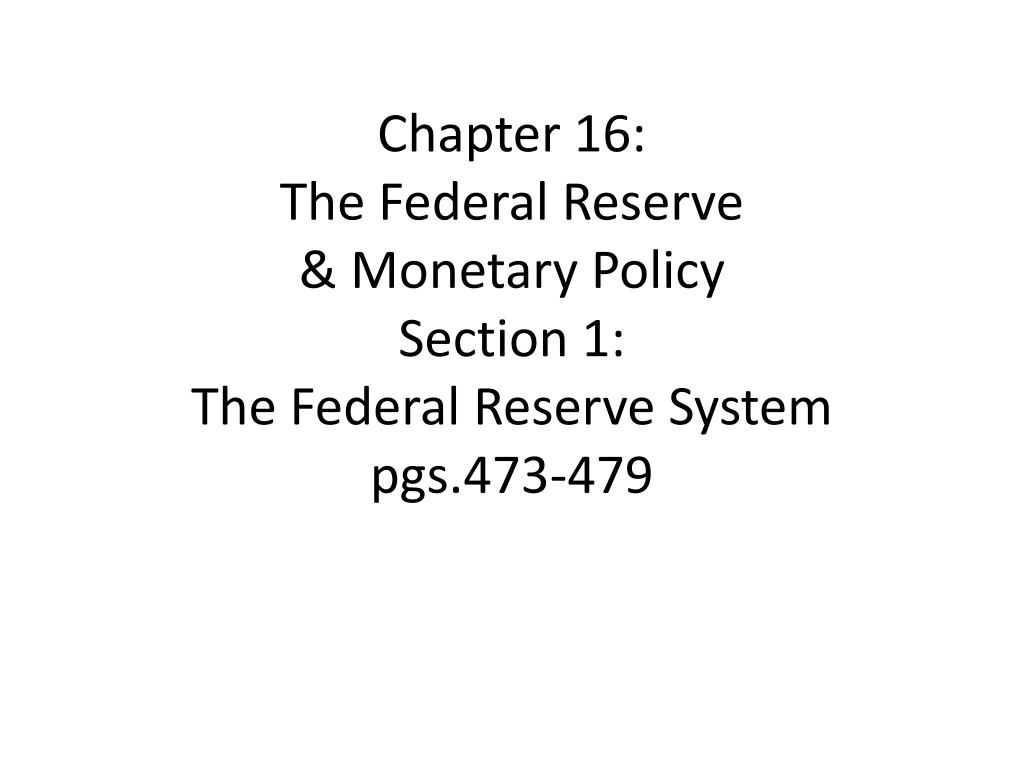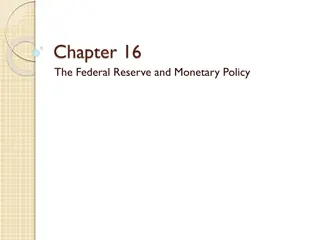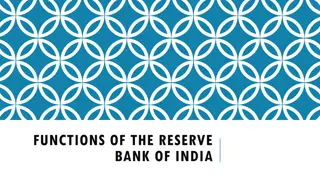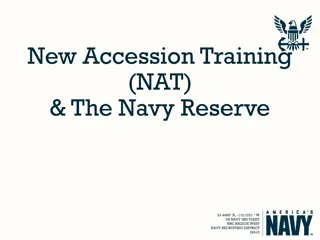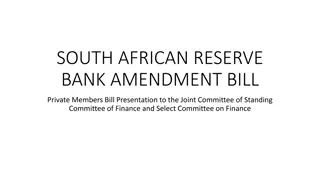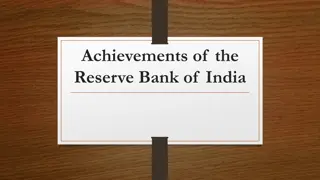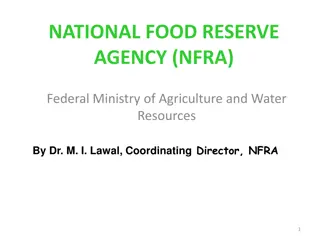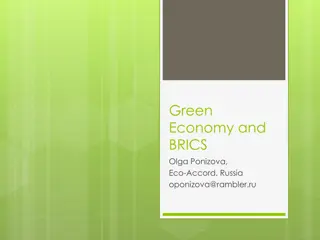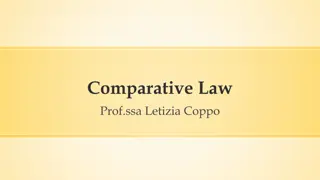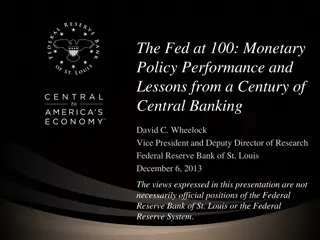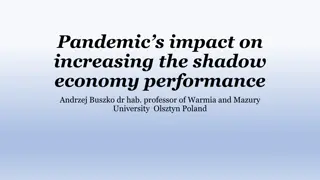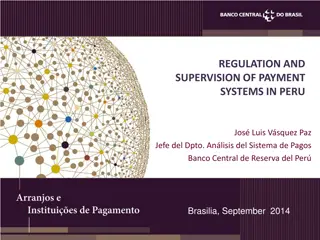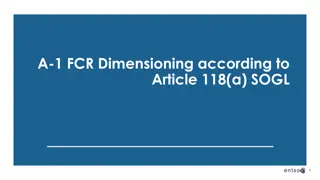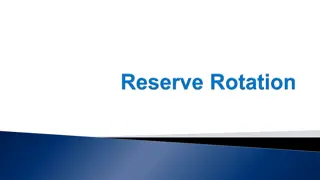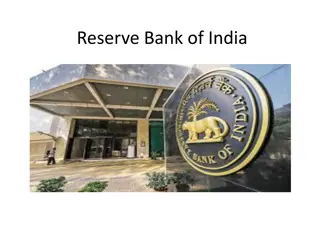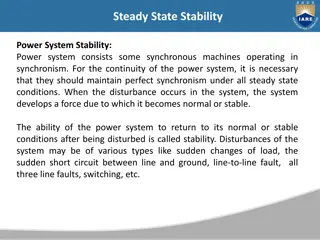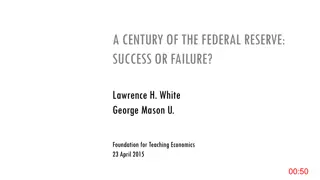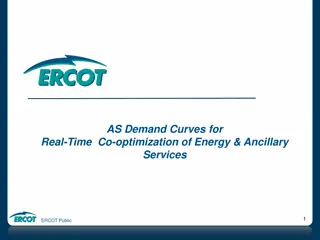The Federal Reserve System: Creating Stability in the US Economy
In 1913, the Federal Reserve Act established the central bank, known as the Fed, to address economic instability. Explore the duties and structure of the Fed, including its role in regulating banks, controlling the money supply, and providing stability during emergencies.
Download Presentation

Please find below an Image/Link to download the presentation.
The content on the website is provided AS IS for your information and personal use only. It may not be sold, licensed, or shared on other websites without obtaining consent from the author. Download presentation by click this link. If you encounter any issues during the download, it is possible that the publisher has removed the file from their server.
E N D
Presentation Transcript
Chapter 16: The Federal Reserve & Monetary Policy Section 1: The Federal Reserve System pgs.473-479
Creating the Fed As you recall from Chapter 10, there were times when the U.S. economy suffered from panics and banking was very unstable. The government made many efforts to address this problem, but had limited success, t/f the Federal Reserve Act was passed in 1913. This created a central bank, which is a nation s main monetary authority, which is able to conduct certain monetary practices. (monetary means relating to money ) The Federal Reserve System is the central bank of the U.S. & is commonly called the Fed. The Fed is an independent organization within the government, which has both public & private characteristics. https://www.soundmoneydefense.org/img/federal-reserve-building-audit.jpg
Duties of a Central Bank http://truedemocracyparty.net/wp-content/uploads/US-FederalReserveSystem-Seal_svg_.png 1. Holding Reserves central banks hold reserves to influence the amount of loanable funds banks have available. This allows the central bank to control the money supply. Assuring Stability the central bank also acts to assure stability in the national bank and monetary systems. Example: it controls the way money is issued and is circulated. Lending Money the central bank lends money to banks & the government. It does not seek to make a profit through lending. 2. 3.
The Duties of the Fed--1 The Fed supervises banking in the U.S. by providing regulation & oversight to make sure that banks follow sound practices in their operations. The Fed also makes sure that banks don t defraud customers. The Fed provides banking services for both private banks and national banks. It accepts and holds deposits in the form of cash reserves, transfers funds between banks or between banks and the government, and makes loans to these institutions. T/f it is called the bankers bank. https://www.freedomsphoenix.com/Uploads/Graphics/173-0625223236-the-fed.jpg
The Duties of the Fed--2 http://news.coinupdate.com/wp-content/uploads/2015/03/us-coins.jpg The Fed is especially important in times of emergency, like during WWI & WWII the Fed sold bonds. The Fed also distributes currency, which is coins and paper money, and regulates the supply of money. The supply of money does not mean cash but all available sources of money. Specifically, the amount of money that banks have available to lend has important effects on the whole economy. (see will study this in section 2) http://www.johnbicycles.com/uploads/2/3/7/9/23799669/6718383_orig.jpg
The Structure of the Fed http://40.media.tumblr.com/6f18b0bc0b9eeaa7ddf44532523053d0/tumblr_inline_nlyiadbjeo1r57lmx_500.png The Fed is different from most countries central banks b/c it is not a single national bank but has both a national and regional structure. This is b/c U.S. citizens were hesitant to give too much power to a national bank.
Elements of the Fed--1 http://www.getagoldira.com/wp-content/uploads/2015/12/janet_yellen_federalreserve_mgn.jpg The Board of Governors is a board of seven appointed members who supervise the operations of the Fed and set policy. They serve for a single 14- year term, with the approval of the senate. The president chooses the chairman and vice- chairman, who serve four-year terms. Janet Yellen
Elements of the Fed--2 http://www.ken-szulczyk.com/economics/macro/fedmap.gif Twelve District Banks The Federal Reserve System is organized into 12 district banks. On this map you see the cities where the Federal Reserve district banks and the offices of the Board of Governors are located. While the district banks are responsible for carrying out the national policy set forth by the Board of Governors, each one also serves the needs of its particular region.
Elements of the Fed--3 Member Banks All nationally chartered banks automatically are members of the Federal Reserve System. State-chartered banks, if they wish, may apply to join the Fed. There are around 2,000 national bank members and 900 state bank members, about 37% of all commercial banks. Each member bank must buy stock in its Federal Reserve district bank. Member banks earn a set dividend rate on the stock they hold. http://home.earthlink.net/~cadman777/komh-fedpyramid.gif
Elements of the Fed--4 http://www.sott.net/image/s13/267790/full/Federal_Open_Market_Committee.jpg The Federal Open Market Committee (FOMC) is a board of the Fed that supervises the sale and purchase of federal government securities. The FOMC consists of 12 voting members, including the Board of Governors, the president who take turns serving one-year terms. The sale & purchases of federal government bonds on the open market are the principal tools used by the Fed to promote a stable, growing economy. At the end of each meeting the FOMC issues a public statement to explain its assessment of the economy and its latest actions.
Elements of the Fed-5 Advisory Councils Three committees provide advice directly to the Board of Governors. The 12 members of the Federal Advisory Council, represent the commercial banking industry. The Consumer Advisory Council advises the board on matters concerning the Fed s responsibilities in enforcing consumer protection laws related to borrowing. The Thrift Institutions Advisory Council was created in 1980. Thrift institutions are savings and loan institutions, savings banks or other institutions that serve savers. The Fed doesn t regulate these institutions, these institutions still must conform to the Fed s requirements & may borrow from the Fed. http://www.mindserpent.com/American_History/federal/fed_res/publications/richmond/images/fedsystem.jpg 1. 2. 3.
